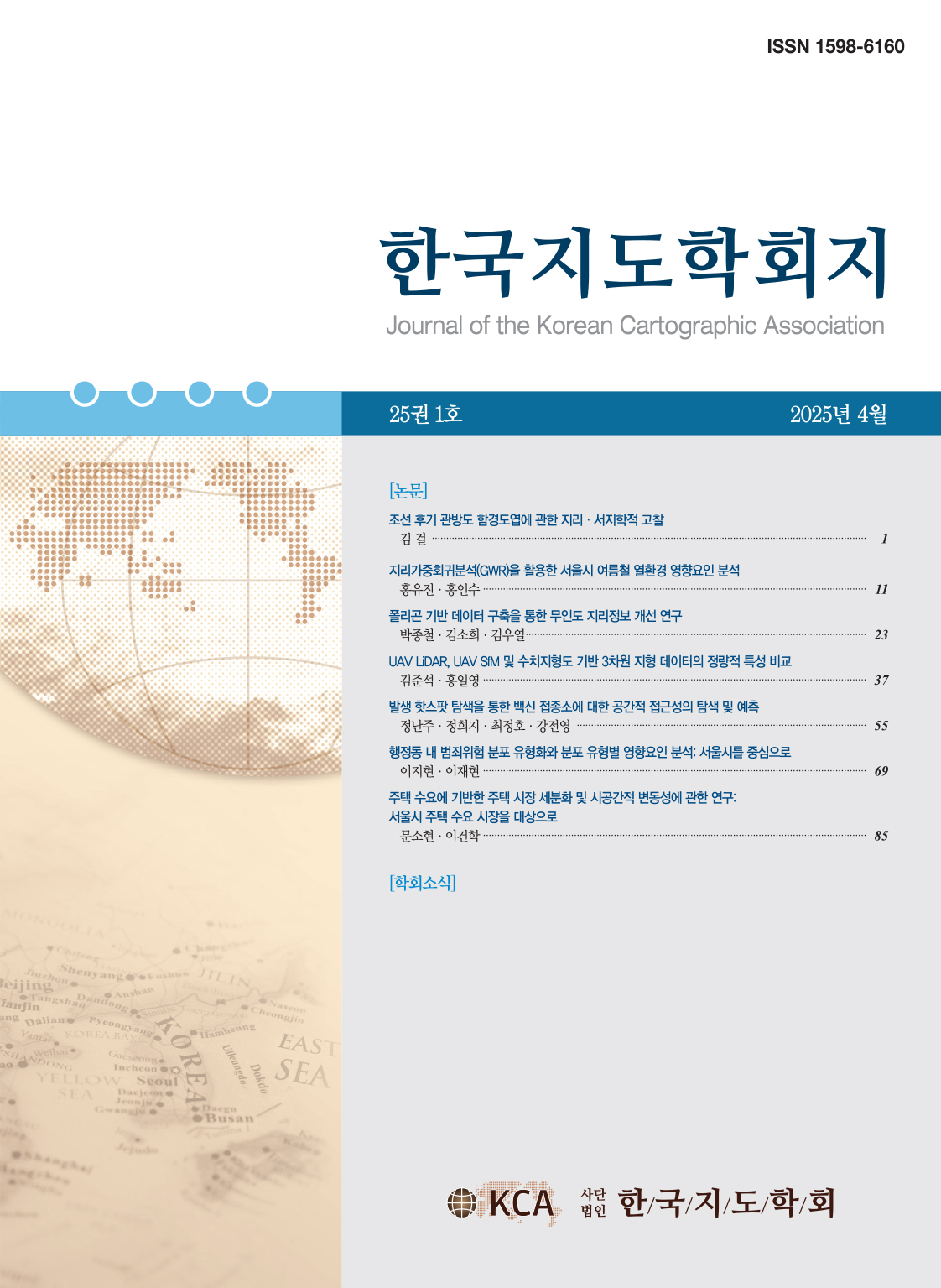Research Article
Abstract
References
Information
Living in non-dwellings violates a right to housing by offering inadequate housing conditions. This article analyzes the spatio-temporal distribution and housing of a Gosiwon, which is the most frequent type of non-dwellings in Korea. First, the result of a spatial kernel density estimation finds four clusters. The spatio- temporal kernel density estimation provides a further evaluation of the clusters, specifically, one relatively recent cluster around Daehak-dong, and older clusters around Yeoksam-dong and Sinchon-dong. Second, a cross type nearest neighbor distance function examines statistically significant spatial clusters from the Gosiwon to subway stations and universities within 90-940, and 210-730 meters, respectively. Finally, the housing conditions and facilities of the Gosiwon are summarized, which shows the minimum size, and the highest rental fee, and the most inadequate housing conditions in Seoul.
비주택은 적절한 주택의 요건을 갖추지 못한 거주공간으로 주거에 부적절한 경우가 많다. 따라서 인간의 적절한 주거에 대한 권리는 비주택에서 주거할 경우 심각하게 침해될 수 있다. 본 연구는 서울시를 대상으로 비주택의 유형 중 가장 큰 비중을 차지하고 있는 고시원의 시공간 분포, 그리고 주거 환경의 지역별 특성에 대하여 살펴보고자 한다. 먼저, 커널 밀도 추정을 이용하여 서울시의 고시원의 공간적 분포를 분석하고 그 결과 대표적인 공간적 군집을 발견하였다. 나아가 시공간 커널 밀도 추정을 통하여, 발견된 대표적 공간적 군집들 중 대학동을 중심으로 한 남서부 지역은 상대적으로 최근 생성된 군집, 역삼동과 신촌동에서는 상대적으로 과거에 생성된 고시원의 군집임을 보였다. 다음으로 교차형 최근린 거리 함수를 이용하여 고시원과 지하철역·대학과의 공간적 연관성을 분석하였고, 그 결과 각각의 시설로부터 90~940m, 그리고 210~730m 사이에서 통계적으로 유의미한 고시원의 군집을 확인하였다. 마지막으로 고시원넷에 게시된 고시원의 정보를 수집하여 서울을 중심으로 수도권에 있는 고시원의 주거 환경을 지역별로 요약하였다. 특히 서울의 고시원은 수도권 내에서도 가장 작은 방 크기, 가장 높은 단위면적 당 임대료, 그리고 가장 열악한 주거환경을 보였다.
- 구동회, 2012, “부산시 최저주거기준 미달가구의 시공간적 변화,” 국토지리학회지, 46(4), 477-487.
- 국가인권위원회, 2018, 「비주택 주거실태 파악 및 제도개선 방안」.
- 국토교통부, 2018, 「주택이외의 거처 주거실태조사」.
- 권정현, 2013, 「고시원 이용실태 및 개선방안」, 서울: 한국소비자원.
- 김용창・최은영, 2013, “서울시 최저주거기준 미달가구의 시공간적 특성과 변화(1955~2010년),” 대한지리학회지, 48(4), 509-532.
- 김의명・홍송표・박진이, 2019, “연속수치지도와 유동인구를 이용한 범죄취약 추정지역 추출,” 한국지도학회지, 19(1), 59-68.
- 김준희, 2013, “고시원에 거주하는 청년층의 실태,” 도시와 빈곤, 102, 35-48.
- 박미선, 2017, “영국의 HMO 주택임대 운영 사례와 시사점,” 국토, 431, 85-92.
- 서안나・김재익・여창환, 2013, “대구광역시 주거빈곤가구의 공간적 분포 특성,” 한국주거학회 학술대회논문집, 247-250.
- 손세린・강영옥, 2017, “서울시 여성운전자 교통사고의 시공간 특성 분석,” 한국지도학회지, 17(2), 89-98.
- 신상영・박지영, 2010, 「서울의 준주택 실태와 정책방향」, 서울: 서울시정개발연구원.
- 이성재, 2010, 「최저주거기준 미달가구 해소를 위한 주거 지원 정책 분석 및 개선방안」, 전주: 전북발전연구원.
- 이헌석・여경수, 2011, “비주택거주민의 주거복지 향상을 위한 법제개선방안,” 공법학연구, 12(3), 363-388.
- 임세희・박경하, 2017, “유형별 주거빈곤가구의 차이-최저주거기준 하위기준미달, 주거비 과부담, 중복주거빈곤가구,” 한국사회정책, 24(4), 31-62.
- 장유선, 2012, “비주택 최저주거기준 외국사례: 영국 HMO, 미국 SRO,” 도시와 빈곤, 99, 27-54.
- 조나혜・강영옥, 2016, “로그데이터의 시공간 데이터마이닝 및 시각화 연구동향,” 한국지도학회지, 16(3), 15-27.
- 최은영・김용창・권순필, 2012, “2011년 신기준에 의한 최저주거기준 미달가구의 시・공간적 변화(1995~2010년),” 부동산학연구, 18(4), 171-195.
- Baddeley A. and Turner R., 2005, spatstat: An R package for analyzing spatial point patterns, Journal of Statistical Software, 12(6), 1-42.10.18637/jss.v012.i06
- Berman, M. and Diggle, P., 1989, Estimating weighted integrals of the second-order intensity of a spatial point process, Journal of the Royal Statistical Society. Series B (Methodological), 51(1), 81-92.10.1111/j.2517-6161.1989.tb01750.x
- Borruso, G., 2008, Network density estimation: A GIS approach for analysing point patterns in a network space, Transactions in GIS, 12(3), 377-402.10.1111/j.1467-9671.2008.01107.x
- Brunsdon, C., Corcoran, J., and Higgs, G., 2007, Visualising space and time in crime patterns: A comparison of methods, Computers, Environment and Urban Systems, 31(1), 52-75.10.1016/j.compenvurbsys.2005.07.009
- Chainey, S. and Ratcliffe, J., 2005, GIS and Crime Mapping. London: John Wiley & Sons.10.1002/9781118685181
- Delmelle, E., Dony, C., Casas, I., Jia, M., and Tang, W., 2014, Visualizing the impact of space-time uncertainties on dengue fever patterns, International Journal of Geographical Information Science, 28(5), 1107-1127.10.1080/13658816.2013.871285
- Diggle, P., 2003, Statistical Analysis of Spatial Point Patterns, 2nd ed., London: Arnold.
- Nakaya, T. and Yano, K., 2010, Visualising crime clusters in a space-time cube: an exploratory data-analysis approach using space-time kernel density estimation and scan statistics, Transactions in GIS, 14(3), 223-239.10.1111/j.1467-9671.2010.01194.x
- Ministry of Housing, Communities and Local Government, 2018, Houses in Multiple Occupation and residential property licensing reform: Guidance for Local Housing Authorities. London:
- Scott, D.W., 1992, Multivariate Density Estimation: Theory, Practice, and Visualization, New York: John Wiley and Sons.
- Silverman, B.W., 1986, Density Estimation for Statistics and Data Analysis, New York: Chapman and Hall.10.1007/978-1-4899-3324-9
- UN Habitat, 2009, The Right to Adequate Housing: Fact Sheet No.21/Rev.1, Geneva: UN.
- 고시원넷, http://www.gosi1.net
- 비즈GIS, http://www.biz-gis.com
- Publisher :The Korean Cartographic Association
- Publisher(Ko) :한국지도학회
- Journal Title :Journal of the Korean Cartographic Association
- Journal Title(Ko) :한국지도학회지
- Volume : 19
- No :2
- Pages :105~118
- DOI :https://doi.org/10.16879/jkca.2019.19.2.105



 Journal of the Korean Cartographic Association
Journal of the Korean Cartographic Association





